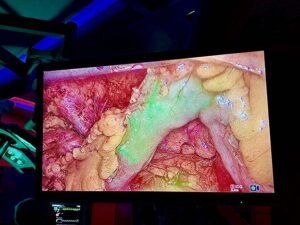A surgery “Laparoscopic Right Colectomy with Extracorporeal Primary Anastomosis” was successfully performed. For the complex operation, the Indocyanine Immunofluorescence technique was used for the first time, benefiting a 63-year-old patient with a clinical diagnosis of colon cancer.

Paraguayan specialists of the Upper Paraná
The surgical procedure was carried out by doctors Emilio Brizuela (oncologist surgeon) and Elías Giani (laparoscopic general surgeon) and a multidisciplinary team of 100% Paraguayan professionals, trained in medicine in Alto Paraná with specializations abroad.
Dr. Emilio Brizuela, an oncologist surgeon, explains what the surgery performed on the patient consisted of, adding that the Tesãi Foundation is the pioneer in the country in the use of this technique.
“Colectomy is the resection of the intestinal segment that is affected by the malignant tumor lesion, which is why it is cancer. We did it minimally invasively with anastomosis, which is the reunion of those sectioned or distanced segments,” said the compatriot specialist, a graduate of the Universidad Nacional del Este (UNE)-class of 2008.
Fluorescence laparoscopy
Indocyanine is a fluorescent cyanine dye that allows visualizing, in real time, the vascular anatomy of the affected segment intraoperatively once the vision on the monitor is activated. The most frequent use is made to measure the perfusion of organs and tissues, it is administered intravenously to stain anatomical structures.
This provides security to the surgical act, because the technique increases the probability of success of the anastomosis because complications may eventually arise that will lead to peritonitis, he assured. “Sometimes the intestinal suture is partially opened, then the content that runs through the digestive tract leaks and that falls into the abdominal cavity and produces a complication such as peritonitis,” she remarked.
Health at the cutting edge in modern medicine
The Area 2 Hospital of the Tesãi Foundation uses advanced technology, through immunofluorescence material. “Indocyanine colors the vascular network green, introducing a camera into the patient’s belly. Once we do that, we section the intestine with the blood vessels to find out how far a good vascularization goes in that intestine”, said Dr. Brizuela.
He added “when we bring the camera closer with a special light, the glasses are dyed green. The success of the anastomosis depends to a large extent on the patient having a good perfusion, that the blood reaches him to a large extent”, also pointing out that the benefits of the approach are notable such as less pain, shorter hospitalization time and quick recovery from the patient as it is a laparoscopic or minimally invasive surgery.
